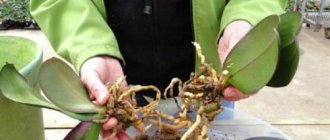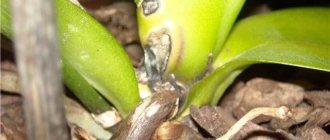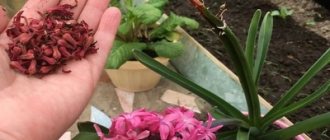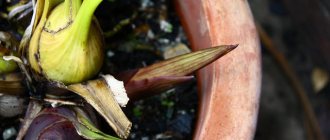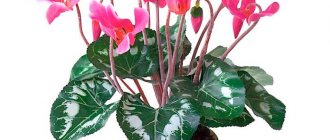Origin story
In the early 19th century, a European importer of tropical plants received interesting bulbous stems in a shipment that were used as packaging material. Out of simple curiosity, he planted them. A very beautiful pale lilac flower has grown. Gradually, their cultivation was brought to a commercial level. Soon they began to visit the tropical jungle in order to search for new species of these exotic plants. Many of them were not transported to their destination, since not all specimens survived the long sea voyage. But those plants that were brought to Europe were very expensive. Later, artificial hybrids began to be grown, and orchids dropped significantly in price. But even now there are rare varieties of these flowers, the price of which reaches $25,000.
Nowadays flower shops have special departments where they sell these plants of any color and size. Also, experienced sales specialists will provide the necessary advice on care after purchase.
We recommend that you read our article “How to choose fertilizers for orchids.”
Reproduction by children on a peduncle
To speed up the growth of children, you can use a special phytohormonal paste. It should be used only in extreme cases, when you urgently need to obtain material for propagating a flower.
It is not recommended to use this method specifically. Children raised in this way often do not take root or produce a weak plant.
In order for a beautiful, healthy flower to grow from a baby, you need to create favorable conditions for its rooting. Otherwise, the plant will simply begin to throw out leaves and side shoots, and the roots will not grow.
For this method of propagation, choose a healthy peduncle with one baby. It must be carefully separated from the mother plant and placed in a plastic container on a layer of moistened sphagnum moss. Cover the container with a lid. This will create the greenhouse effect necessary for growth.
Do not rush to replant the plant into a pot after the first roots appear.
Until the baby produces 4-5 healthy leaves and the roots grow to at least 5 cm, this should not be done. This method allows the young plant to learn to feed itself. Another advantage of this method is that the roots grow straight into the pot. And this greatly simplifies the process of transplanting a new orchid.
Features of flower culture
The unique feature of orchids is their endless variety of colors and shapes. Most likely, this is what attracts gardeners to these flowers, because they can be quite inconspicuous; there are even varieties whose flowers are 2 millimeters in size. Orchids also differ in their methods of reproduction. Their seed capsules contain about 2 million seeds, which are easily dispersed by the wind. But for them to grow, they need a special mushroom to supply them with nutrients.
Although not unusually beautiful, the flower does not have pollen to attract pollinating insects, and not all species even have nectar. Therefore, the main advantage of these flowers is considered to be beauty, camouflage and aroma.
Today, more than 75,000 species of orchids are known.
Flowering has ended, what should I do?
When the peduncle begins to dry out a little, there is no need to rush to trim it. For some time, it will serve as a source of nutritional juices for the entire flower. Only when the flower turns yellow is it removed, and a stump 2-2.5 cm in size is left at the site of removal. Young buds may appear, which will bloom over time.
In another case, the tip of the peduncle dries out, and subsequently a baby is formed. In some cases, if necessary, the peduncle is cut off. When cutting the orchid 1-1.5 cm above the dormant buds, re-blooming may occur. However, it should be remembered that the forced development of the old peduncle inhibits the formation and development of a new one.
Flower cultivation
Many of us know that in their homeland these flowers can grow freely on other plants, for example, in the crowns of large trees, but this does not mean that they cannot be grown at home, in ordinary pots. Therefore, today we are looking at the features of growing orchids and learning how to propagate them at home.
In what containers should I grow orchids at home?
Most often, at home, flowers are planted in pots, plastic or clay. Which option should I choose?
Growing orchids in clay pots often leads to their disease and wilting. This happens for many reasons, including minimal space for roots, moisture absorption and roots sticking to the surface of the vessel, as well as poor water drainage, due to which the rhizomes can rot.
With plastic pots, everything is a little different, and that is why floristry experts recommend using exclusively plastic containers for growing orchids.
In such cube-shaped containers there are no places where the root system will be pinched and suffer from a lack of free space for development. Most often, plastic containers are equipped with good water drainage and stands, due to which not only excess moisture is removed from the container, but also the root system has the opportunity to be ventilated. These factors create the most convenient conditions for development for the orchid.
Necessary conditions of detention
Capacity
Choosing a container for an orchid is an important factor and should not be neglected. Since this is an epiphytic plant, it means that its roots are most often almost completely located on the surface of the soil (tree). This means that roots need indirect sunlight to photosynthesize. For these purposes, the pot must be transparent.
It should also be equipped with a large number of drainage holes, not only at the bottom of the pot, but also on the sides closer to the bottom. This will ensure that not only does excess water get rid of after watering, but also with the help of these holes the roots will be able to breathe oxygen.
The orchid pot should have a large number of holes.
Main qualities of an orchid pot:
- complete transparency of the walls;
- small size;
- many holes for air access and water drainage after watering;
- the walls inside should be smooth so as not to injure the root system of the plant.
A pot with a raised bottom is purchased for the pot so that water after watering does not come into contact with the roots.
IMPORTANT! When choosing a container for a flower, you need to pay attention to the factors necessary for the growth of the flower. And for beauty, at the time of photographing, you can transfer the flower to another beautiful ceramic pot.
Substrate
An orchid requires a special substrate made from bark. In specialized stores there are many different soils “For Orchids”, which were developed by various manufacturers.
It contains only natural materials that can nourish the roots of the plant and be breathable.
At the first signs of soil damage, the plant needs to be urgently replanted.
Basic soil requirements for orchids:
- breathability. This helps achieve the core;
- stability. The bark should not decompose quickly, causing rot;
- the soil should not allow bacteria to grow.
But many gardeners involved in growing orchids have long been advised to make the soil with their own hands. For this you will need:
- bark – the fractions should be small in size, approximately 2x2 cm;
- coconut fiber – it is sufficiently permeable to air, environmentally friendly and moisture-absorbing;
- sphagnum moss is a useful natural additive for plants;
- charcoal – helps get rid of fungal diseases;
- leaf humus.
Components of the substrate.
All components are mixed and disinfected by freezing in the refrigerator compartment for 24 hours.
IMPORTANT! All components taken to prepare the soil must be taken away from roads and populated areas so that they do not contain harmful vapors and chemical impurities.
Temperature and humidity
Orchids can be kept at temperatures ranging from 15-25 degrees Celsius. Small fluctuations of 5 degrees between night and day temperatures are not only not harmful for the plant, but also useful, as this stimulates the growth of the flower bud.
Therefore, if a flower bush has not bloomed for a long time, then it needs to create temperature differences , and you can expect a peduncle to appear from the waiting bud.
Air humidity is an important part in the process of growing an orchid, and if it is not enough, then the flower must provide it by placing containers of water . As it evaporates, it will increase the humidity around the plants.
You also need to remember that low humidity can contribute to the appearance of mites . But it is impossible to increase the humidity by spraying the leaf mass and flowers, as this can lead to the appearance of unsightly spots that will spoil the appearance of the flower.
Orchids: cultivation and care
Growing temperature
Orchids feel quite good at home, even of the standard type. For a comfortable life, they need a temperature of +25+30°C, but in winter they should ensure a temperature of +20°C. But you should not take flowers out onto balconies and terraces, where the air temperature can drop below +13+14°C, as in such conditions they will quickly die or begin to get seriously ill.
Accommodation
Orchids are very demanding of lighting, and therefore, if you provide the brightest day possible and a little additional light in winter, you will systematically receive pleasant plant growth and abundant flowering. But be careful, because the hot summer rays can seriously burn the leaves.
It would be most correct to place a flower pot on the east window, but if this is not possible, then windows on the south or west side will do. Soon the plant itself will tell you whether it has enough light in the place where you installed it. If the leaves begin to lighten, then you will need to shade the plant a little; if they take on deep green tones, then, on the contrary, install it in a more illuminated place.
Watering the plant
Orchids love moisture, however, watering should be moderate so that the soil is not flooded and water stagnation does not form in it. The ideal would be to systematically moisten the soil, without excessive amounts of water.
Humidity
Keeping a flower crop indoors will require adjusting the humidity, but this does not mean that the plant will need to purchase a greenhouse with fogging; it will be enough to grow the flower at a humidity of 70% or spray it if the humidity drops to 40-50%.
How to fertilize
Plants need nutritious soil and actively consume nutrients necessary for growth and flowering. It would be most correct to provide the flower with fertilizing during every second or third watering. Azofoska (1 g per 1 liter of water) is best suited for such frequent feeding. You can also fertilize with magnesium sulfate (2 g per 1 liter of water), but it is better to spray the plant with this solution (only once every 25-30 days).
Soil, pots and fertilizers
The main function of the soil is to maintain the orchid in an upright position, while allowing enough air to pass through to the root system and minimal moisture retention. Therefore, the soil for this plant is prepared without adding garden soil. The soil itself consists of: clay, sifted sand, moss, cork, bark, coal and various additives. All this should be perfectly mixed and crushed.
You can use a wide variety of pots for orchids, starting with a simple plastic container that has holes to drain excess moisture.
Orchids are one of those plants that grow quite well without feeding. But it is still possible to use fertilizers, in some cases it is even necessary. Fertilizing should be done during the growth period, approximately once every 20 days, with mineral fertilizers diluted in water.
Orchid propagation
Transplantation and propagation of a crop can occur in several ways, and therefore you have an excellent opportunity to choose the most convenient one for yourself.
Propagation by dividing rhizomes
A fairly simple method that, as they say, can be used to propagate almost any type of orchid. You need to select an adult and large enough plant, carefully remove it from the pot or container and separate the rhizome from its walls and earthen ball. The rhizome should be divided with a very sharp knife, cutting it into any number of parts, the main thing is that each of them has at least 3 developed false bulbs. Next, the roots are sprinkled with charcoal for disinfection, the orchid is planted in separate containers and provided with standard care.
This method can only be practiced in the spring.
Propagation by seeds
Many florists, and just flower lovers, are wondering whether it is possible to grow orchids from seeds. Answering the specific question asked, we will say yes... but not at home, but in the laboratory.
Why is that? Everything is very simple, because in nature, very small plant seeds develop due to the root sponge or mycorrhizal fungus root, from where they receive all the nutrients. The orchids that we grow at home do not have nutrient tissue at all, and therefore they need to create a nutrient medium artificially. You could try to grow flowers using hydroponics or a similar method, but using it will develop not only the seed itself, but also mold fungi. This is where a paradox arises, because by killing mushrooms, we will also kill the flora... In general, to put it briefly, in artificially created conditions, an orchid can only be propagated by seeds in a sterile laboratory, and even then it will take from 1.5 to 5 years to grow it, and some varieties will bloom only by 10 years.
Reproduction by shoots
Some species of our wonderful flowers may have side shoots, or, as people say, “babies”. These are separate shoots from the mother specimen that develop next to it, and therefore, if you want to propagate an orchid in a similar way, then pay attention to their cultivation. At a certain point, after care and constant spraying, the side shoot is separated and planted in a separate container, as an independent plant.
If you want to grow “babies” faster, try to provide individual shoots with increased attention - spraying with fertilizers with a high nitrogen content, increased temperature in the flower growing room, adding special components (meristems), which are the educational tissue of plants. When separating and replanting a shoot, do not forget to treat the roots with charcoal.
Propagation by cuttings
A few varieties of orchids, for example, Vanda, can be propagated by apical cuttings, but only if there are certain distances between the developed nodes of the shoots.
To do this, use a sterile knife, with which the shoot is cut at an angle along approximately half of its entire growth. The cuts are disinfected with charcoal, and the cutting is planted in a separate pot. Further, only constant and stable care for the new plant, and the expectation that the cutting will grow quickly, because this method should be used only for fast-growing species.
Nutrient medium
When growing orchid seeds, Knudson's medium is often used (this is a special solution prepared according to a specific recipe). This mixture is ideal for producing orchid seedlings in a regular kitchen.
Measure out 150-200 ml of water, preferably distilled. Pour it over pre-prepared agar-agar for a couple of hours, after swelling, place the container in a pan of boiling water and wait until completely dissolved. Do not keep agar in boiling water for too long - this will lead to a deterioration in its quality. As the agar-agar melts, add the components of Knudson's proto-feed to it, preferably in the order in which they are located in the recipe.
Using litmus paper, we determine the acidity of the resulting solution. After mixing the solution, it will be almost neutral, about 6.5-7 pH. For orchids, a suitable environment is between 4.8 and 5.2 pH. For acidification, dilute acids (hydrochloric or nitric) are used. You only need to add a couple of drops to the solution. Then mix the substance and determine its pH again. If you do not get the required acidity, then the manipulation must be repeated.
The resulting mixture is drained and slightly reheated in boiling water, remembering to stir constantly. After this procedure, you will have the necessary environment ready. Let's move on to the next stage.
Pests and elimination methods
Thrips
You can recognize thrips on a plant only by noticing silvery and bluish inclusions on the leaves. The cause of the spread of this scourge is considered to be elevated temperature, and thrips can only be controlled by treating them with insecticides.
Spider mite
Pests can be detected by the small silver-white cobwebs that cover the lower part of the leaves. At the same time, the upper part of the leaves becomes covered with yellow and white spots. The cause of the pest is too dry air, and you can fight it with soap and alkaline washes.
Aphid
We have all known aphids for a long time, which means it will be easy to recognize them. These are very small, dark or green insects that settle throughout the plant. The cause may be increased temperature and low humidity. Spraying with a milk-water solution (1:1) or light insecticides will help remove aphids from the plant. We recommend that you find out what a garden orchid is.
Shchitovka
Small lice form growths on orchid leaves, under which they live. The reason is high indoor temperature. Scale insects can be eliminated by washing with a soap-alkaline solution.
Caring for the plant during flowering
During the flowering period, it is necessary to continue to care for the orchid in the same way as before. If she blooms, then she feels good. This means the florist is doing everything right.
You need to remember the following:
- care continues according to the same pattern;
- buds that have already bloomed need to be removed;
- if they are not disclosed at all or partially, it is necessary to review the rules of care;
- It is prohibited to replant the crop during the flowering period.
These are the basic rules you need to know. If they are disturbed, the phalaenopsis may experience stress. As a result, flowering will stop, and the buds will quickly wither and fall off.
Overseas beauty orchid (20 photos)
How to grow a lot of orchids at home?
In fact, there are no problems. If the flowers are of the same species, but of different varieties, then you only need to properly care for them, namely:
- water;
- observe the temperature regime;
- provide lighting;
- maintain air humidity;
- apply fertilizing.
Reference. If there are a lot of orchids in the room, and insects periodically fly into the window, pollination can occur. Then the flowers will give seeds. And this is an excellent opportunity to start a business selling representatives of this family. On the market, the average price of an orchid is 2,500 rubles. Hobbyists are ready to buy some species for $5,000!
Top dressing
To feed the orchid, liquid fertilizers are suitable, which are used once every three weeks. A fertilizer containing nitrogen, phosphorus, and calcium is suitable. The introduction of nutrients stimulates growth and the flowering process. You need to fertilize the flower only in the active growth phase. One feeding every two weeks will be enough.
Fertilizers for orchids
Before you start fertilizing, you should soak the orchid roots, and only then add fertilizer. At the end of the process, you need to let the plant “rest” for 20 minutes without external intervention.


